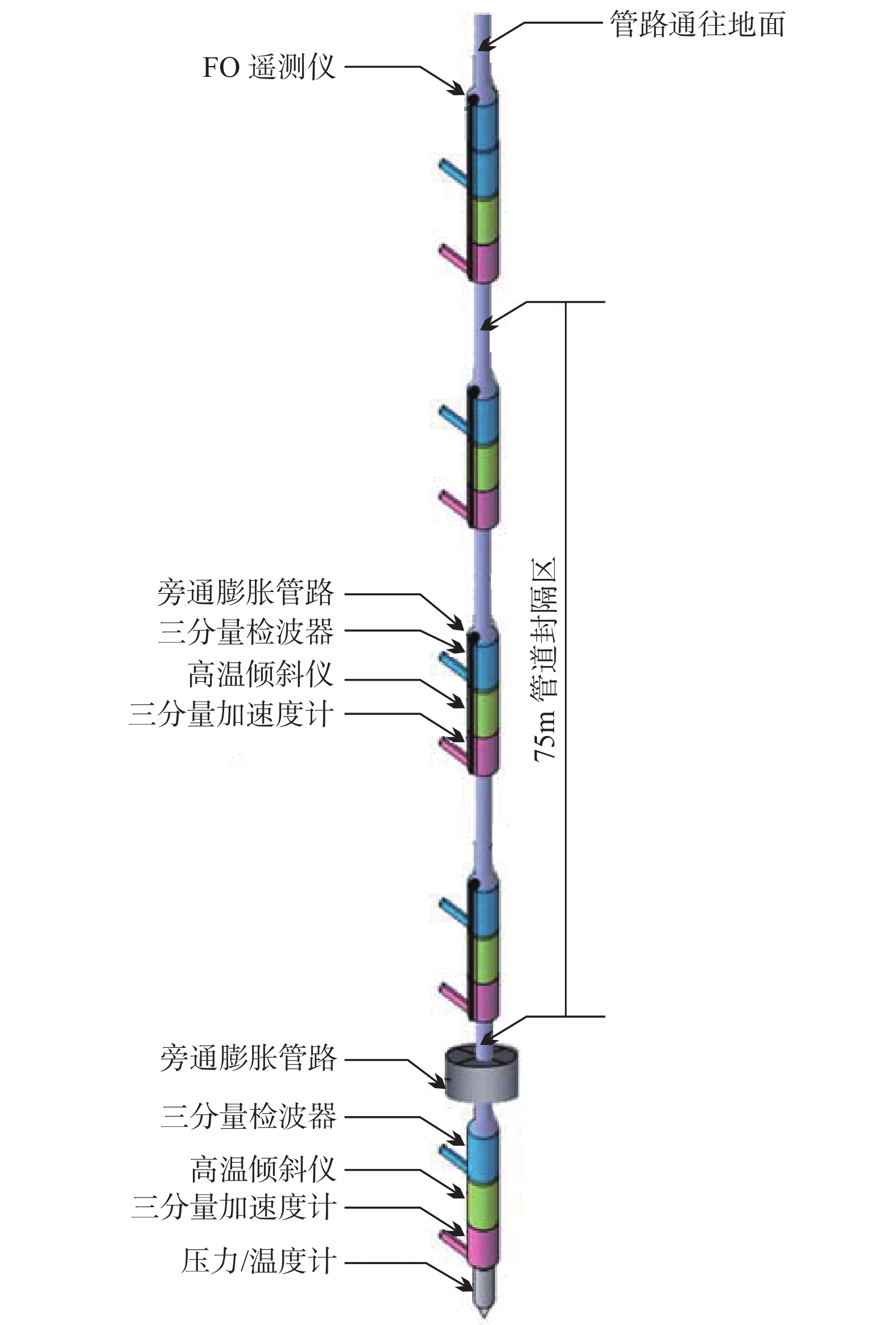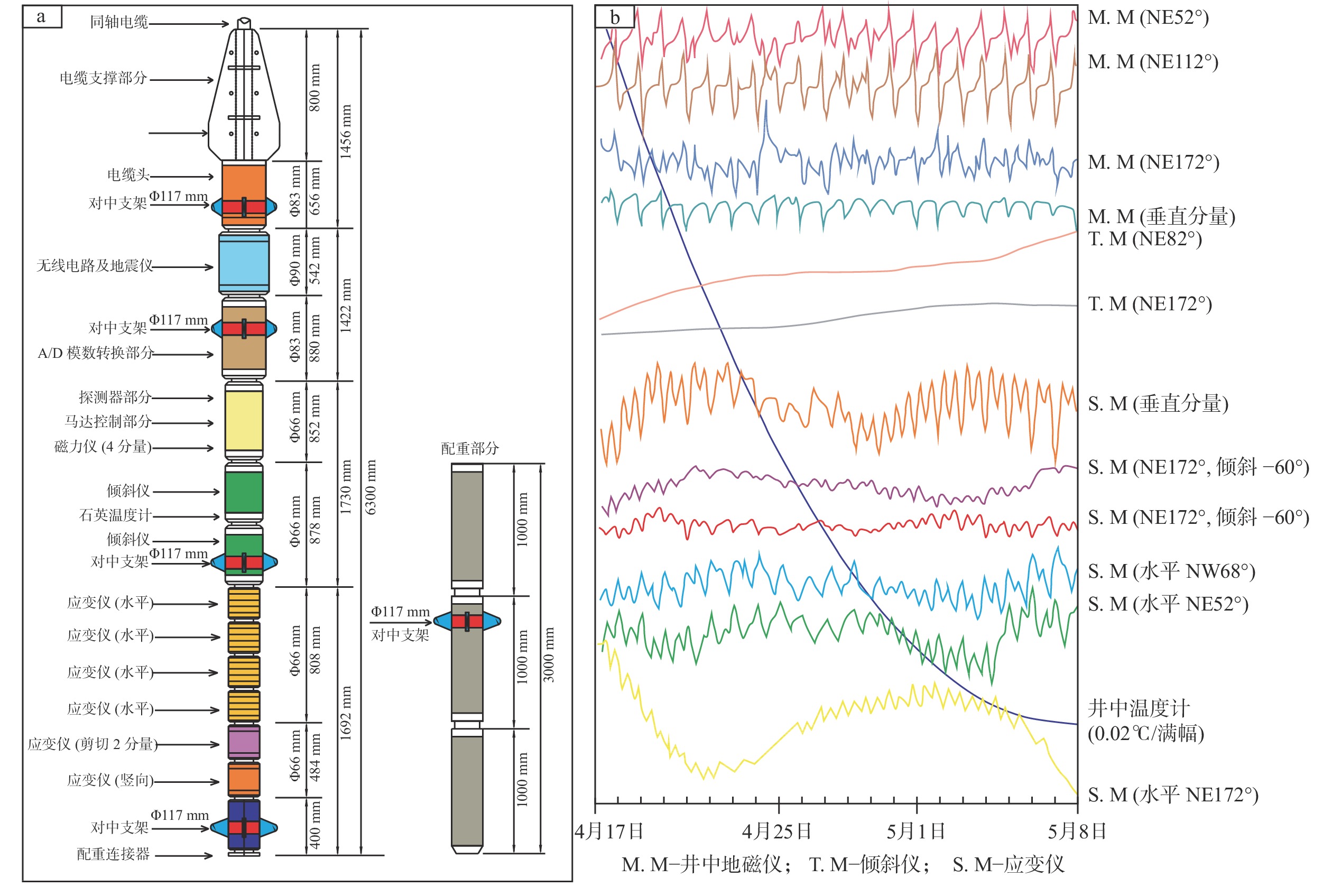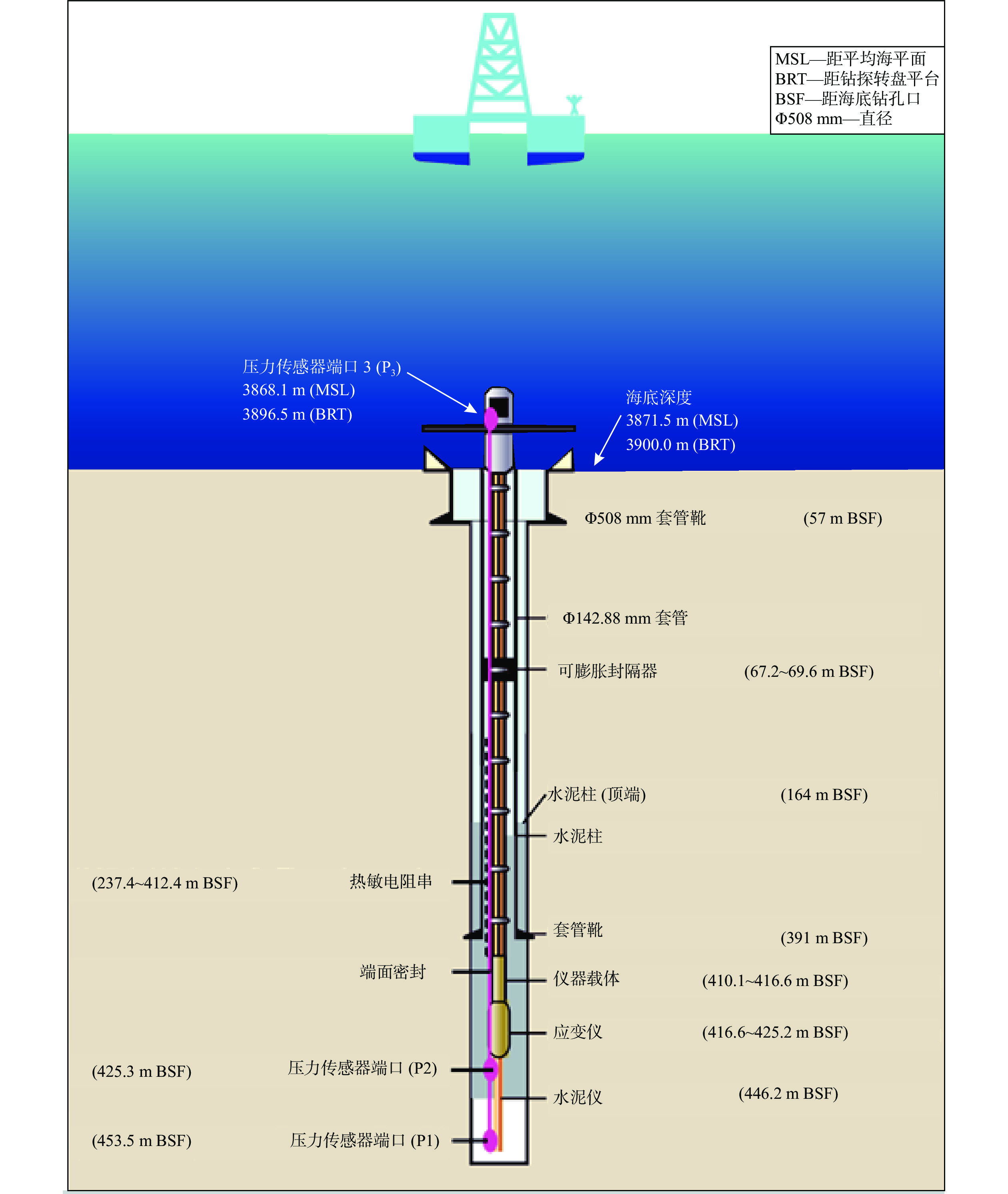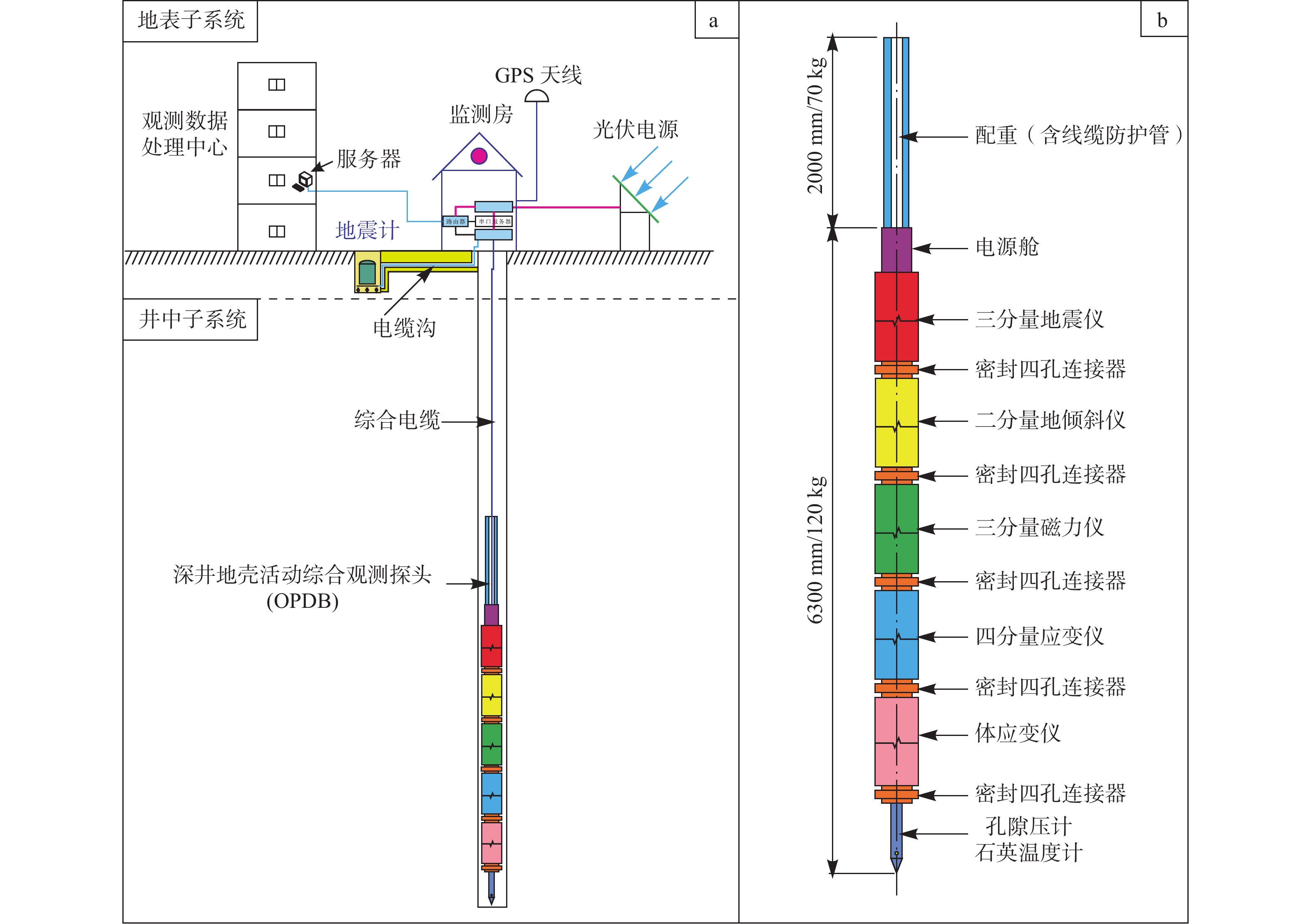A brief talk on comprehensive crustal activity observation technology of deep-holes
-
摘要:
岩石圈在地球内动力作用下,塑造出不同类型的地球表面形态,而通过钻孔地壳活动综合观测技术捕捉地壳应力状态及其动态变化规律,是人类认识地球内动力过程、研究内动力地质灾害机理的重要途径。文章总结了日本、美国等发达国家以及IODP国际合作研究计划在发展钻孔地壳活动综合观测技术方面的贡献,并对中国钻孔应变观测技术及其观测仪器发展历程、研发现状进行了系统性的总结,尤其是“十三五”以来,在深地深海探测国家战略的大背景下,中国地质调查局、中国地震局等单位相继完成井中综合地球物理观测系统研发工作,并在陆域综合观测站中完成野外验证。其中,中国地质科学院地质力学研究所利用系统集成关键技术成功研制的地壳活动综合地球物理观测系统,拥有应变、倾斜、地震、地磁、地温、孔隙压等多种传感器和15个分量,具备观测地壳变形、应力、应变、倾斜、地震及其诱导的地温、水文、地电、地磁等岩石圈地球动力相对变化的能力,已在甘肃山丹(安装深度253 m)、四川平武(WFSD-4,1600 m)观测站投入使用,取得了一定的成效,对中国未来突破3000 m深井地壳活动综合观测技术具有指导意义,可为地球动力学研究、深部矿产和地热资源安全开采、内动力地质灾害预测提供重要地应力动态变化信息。同时,以“十四五”深地深海探测国家战略为契机,提出了深井地壳活动综合观测系统的未来发展方向和构想。
Abstract:Under the action of the Earth’s inner dynamics, the lithosphere shapes different types of the Earth’s surface, and the crustal stress state and its dynamic change law are captured by the comprehensive observation technology of drilling crustal activity. It is an important way for human beings to understand the internal dynamic process of the Earth and study the mechanism of inner dynamic geological hazards. The contribution of developed countries such as Japan, the USA, and the IODP International Cooperative Research Program to the development of integrated borehole crustal observation technology is summarized in this paper. The paper also systematically reviews the development history and present situation of borehole strain observation technology and borehole strain observation instrument in China. Especially since the 13th Five-Year, under the background of the national strategy of deep-sea exploration, the China Geological Survey Bureau (CGS), the China Earthquake Administration, and other systems have successively carried out research and development of the integrated geophysics observation system in wells, and have been put into use in integrated land and sea observation stations. The Institute of Geomechanics has successfully developed an integrated geophysics observation system for crustal activity using the key techniques of system integration. The system has a variety of strain, tilt, seismic, geomagnetic, geothermal, pore pressure, other sensors, and 16 components capable of observing crustal deformation, stress, strain, tilt, earthquake, and their induced geodynamic changes in the lithosphere, such as geotemperature, hydrology, geoelectricity, geomagnetism, etc. It has been put into use in Shandan (installed depth 253 m) and Pingwu (WFSD-4, 1600 m) observatories in Gansu and Sichuan provinces and has achieved initial results. It is a milestone for our comprehensive crustal activity observation technology to break through the 3000-meter-deep well in the future. It can provide vital information for geodynamics research, safe exploitation of deep mineral and geothermal resources, and prediction of internal dynamic geological hazards. At the same time, based on the national strategy of deep-sea exploration in the 14th Five-year, the future development direction of integrated observation system of deep-well crustal activity is pointed out.
-

-
图 1 美国Parkfield地震实验场深部钻孔计划(据Zoback et al., 1998修改)
Figure 1.
图 2 Parkfield深井综合观测仪(据彭华等,2011修改)
Figure 2.
图 3 日本深井地壳综合观测装置及其监测曲线(据苏恺之等,2003a;徐纪人和赵志新,2006修改)
Figure 3.
图 4 IODP钻孔长期监测系统(C0006G孔;据Kinoshita et al., 2018a修改)
Figure 4.
图 5 深井地壳活动综合观测系统(据彭华等,2011a修改)
Figure 5.
-
[1] CAI M F, JI D, GUO Q F, 2013. Study of rockburst prediction based on in-situ stress measurement and theory of energy accumulation caused by mining disturbance[J]. Chinese Journal of Rock Mechanics and Engineering, 32(10): 1973-1980. (in Chinese with English abstract)
[2] CAI M F, 2020. Key theories and technonogies for surrounding rock stability and ground control in deep mining[J]. Journal of Mining and Strata Control Engineering, 2(3): 033037. (in Chinese with English abstract)
[3] CAI M F, DUO J, CHEN X S, et al. , 2021. Development strategy for co-mining of the deep mineral and geothermal resources[J]. Chinese Strategic Study of CAE, 23(6): 43-51. (in Chinese with English abstract)
[4] CAI M F, MA M H, PAN J L, et al. , 2022. Co-mining of mineral and geothermal resources: a state-of-the-art review and future perspectives[J]. Chinese Journal of Engineering, 44(10): 1669-1681. (in Chinese with English abstract)
[5] CHEN X L, ZHANG Y L, CAI W X, 1989. Continuous crustal movement observation technique[M]. Beijing: Seismological Press. (in Chinese)
[6] CHI S L, 1977. Continuous self-recording pressure volume geostress meter[C]//Selected papers of national geostress conference (II). 369-373. (in Chinese)
[7] CHI S Y, 1982. Preliminary experimental result of a capacitance-type bore-hole earth strain meter[J]. Acta Seismologica Sinica, 4(1): 98-103. (in Chinese with English abstract)
[8] FENG C J, LI B, LI H, et al. , 2022. Estimation of in-situ stress field surrounding the Namcha Barwa region and discussion on the tectonic stability[J]. Journal of Geomechanics, 28(6): 919-937,doi: 10.12090/j.issn.1006-6616.20222820. (in Chinese with English abstract)
[9] G T 163, MGMR, 1971. Summary of steel string gauge survey[J]. Earthquake Front, 3. (in Chinese)
[10] GLADWIN M T, 1984. High-precision multicomponent borehole deformation monitoring[J]. Review of Scientific Instruments, 55(12): 2011-2016. doi: 10.1063/1.1137704
[11] GLADWIN M T, HART R, 1985. Design parameters for borehole strain instrumentation[J]. Pure and Applied Geophysics, 123(1): 59-80. doi: 10.1007/BF00877049
[12] HART R H G, GLADWIN M T, GWYTHER R L, et al. , 1996. Tidal calibration of borehole strain meters: removing the effects of small-scale inhomogeneity[J]. Journal of Geophysical Research: Solid Earth, 101(B11): 25553-25571. doi: 10.1029/96JB02273
[13] HICKMAN S, ZOBACK M, ELLSWORTH W, 2004. Introduction to special section: preparing for the San Andreas fault observatory at depth[J]. Geophysical Research Letters, 31(12): L12S01.
[14] ISHII H, 2001. Development of new multi-component borehole instrument[J]. Report of Tono Research Institute of Earthquake Science, 6: 5-10. (in Japanese)
[15] ISHII H, YAMAUCHI T, MATSUMOTO S, et al. , 2002. Development of multi-component borehole instrument for earthquake prediction study: some observed examples of precursory and co-seismic phenomena relating to earthquake swarms and application of the instrument for rock mechanics[M]//ANDO M. Seismogenic process monitoring. London: Routledge: 365-377.
[16] JIANG J X, YIN G H, HASIGAOWA, 2000. Recordings in bore-hole strainmeter before earthquake and earthquake prediction[J]. Journal of Seismological Research, 23(4): 410-417. (in Chinese with English abstract)
[17] JIANG J X, WANG Z H, LI C, et al. , 2003. Borehole strain anomaly and strong earthquake activity in Xinjiang[J]. Inland Earthquake, 17(2): 126-133. (in Chinese with English abstract)
[18] JIANG J X, YIN G H, WANG Z H, et al. , 2004. Statistical character of steping change anomality of component-type borehole strain and its application to earthquake prediction in Xinjiang[J]. Chinese Journal of Rock Mechanics and Engineering, 23(23): 4072-4078. (in Chinese with English abstract)
[19] JIANG J X, YIN G H, WU G D, 2012. Study of Xinjiang relative stress field based on continuous borehole stress and strain data[J]. Chinese Journal of Rock Mechanics and Engineering, 31(1): 154-163. (in Chinese with English abstract)
[20] KINOSHITA M, BECKER K, TOCZKO S, et al. , 2018a. Expedition 380 methods[C]//Proceedings of the international ocean discovery program. College Station: International Ocean Discovery Program.
[21] KINOSHITA M, BECKER K, TOCZKO S, et al. , 2018b. Site C0006[C]//Proceedings of the international ocean discovery program. College Station: International Ocean Discovery Program.
[22] KOKO ISHII, 2001. Development and observation of a new borehole integrated observation device for crustal activity[J]. Dongnon Institute of Earthquake Science(6): 5-10. (in Chinese)
[23] KOPF A, SAFFER D, TOCZKO S, 2017. Expedition 365 summary[C]//Proceedings of the international ocean discovery program. College Station: International Ocean Discovery Program.
[24] LI H L, MA H J, ZHANG J, et al. , 2004. The design of FZY-1 type multi-component borehole strain meter[J]. Seismological and Geomagnetic Observation and Research, 25(1): 69-77. (in Chinese with English abstract)
[25] LI M W, 1987. The soil layer stress precursors of the Wuqia earthquake (Ms=7.4)[J]. Inland Earthquake, 1(1): 77-83. (in Chinese with English abstract)
[26] LIU W H, ZHENG J W, ZHAO J D, et al. , 2019. Management mechanism and enlightenment of ocean drilling programs[J]. World Sci-Tech R & D, 41(1): 77-87. (in Chinese with English abstract)
[27] LUO M J, GU M L, LI A Y, et al. , 1989. Borehole strain--stress calibration in the same place by use of tidal generation force[J]. Crustal Deformation and Earthquake, 9(4): 51-62. (in Chinese with English abstract)
[28] LUO M J, TANG J A, 2016. Calculation of subsurface strain and stress using four-component borehole strain observations[J]. China Earthquake Engineering Journal, 38(S1): 8-15. (in Chinese with English abstract)
[29] Ma X Y, 1987. Summary of the lithospheric dynamics in China [J]. Acta Geologica Sinica, (2): 113-125.
[30] MENG W, TIAN T, SUN D S, et al. , 2022. Research on stress state in deep shale reservoirs based on in-situ stress measurement and rheological model[J]. Journal of Geomechanics, 28(4): 537-549,doi: 10.12090/j.issn.1006-6616.2022041. (in Chinese with English abstract)
[31] OUYANG Z X, 1977. RDB-1 capacitive ground strain gauge[C]//Selected papers of national geostress conference (II). Beijing: Seismological Press: 337-348. (in Chinese)
[32] OUYANG Z X, 1983. A high precision capacitance borehole strain measurement system[C]//Selected papers of the second national conference on geostress. Beijing. (in Chinese)
[33] OUYANG Z X, 1986. High-precision component borehole strain gauge developed[J]. Earthquake(2): 61. (in Chinese)
[34] OUYANG Z X, ZHANG Z R, 1988. Studies of method for coupling strainmeter and borehole wall[C]//Tectonic and crustal stress collection (2). Beijing: Seismological Press. (in Chinese)
[35] OUYANG Z X, ZHANG Z R, SHU G L, 2004. Review and outlook for West China borehole strainmeter networks[J]. Chinese Journal of Rock Mechanics and Engineering, 23(23): 4058-4062. (in Chinese with English abstract)
[36] OUYANG Z X, ZHANG J, CHEN Z, et al. , 2009. New progress in multi-component observation of crustal deformation in deep boreholes[J]. Recent Developments in World Seismology(11): 1-13. (in Chinese with English abstract)
[37] OUYANG Z X, 2013. Research on in-situ calibration technique of RZB borehole strainmeters[J]. Journal of Geodesy and Geodynamics, 33(1): 153-156. (in Chinese with English abstract)
[38] PAN L Z, 1980. Directional measurement of ground stress and ground strain [J]. Journal of Mechanics and practice, 20-33. (in Chinese)
[39] PAN L Z, 1986. Borehole deformation method for in-situ stress measurement of multi-contact preloaded elements [J]. 29(5): 468-481. (in Chinese with English abstract)
[40] PENG H, MA X M, JIANG J J, et al. , 2011a. Research and demonstration report on combined stress-strain multi-parameter automatic monitoring technology of borehole[R]. Beijing: Institute of Geomechanics, Chinese Academy of Geological Sciences. (in Chinese)
[41] PENG H, MA X M, JIANG J J, et al. , 2011b. Development report of integrated geophysical monitoring system for middle-deep Wells[R]. Institute of Geomechanics, Chinese Academy of Geological Sciences. (in Chinese)
[42] QIU Z H, ZHANG B H, 2002. Current Situation of the seismological networks for borehole stress-strain precursor surveilance in China[J]. Recent Developments In World Seismology(6): 5-9. (in Chinese with English abstract)
[43] QIU Z H, XIE F R, SU K Z, et al. , 2004. New era of borehole strain observation[J]. Recent Developments in World Seismology(1): 7-14. (in Chinese with English abstract)
[44] QIU Z H, SHI Y L, OUYANG Z X, 2005a. Absolute calibration of 4-component borehole strainmeters[J]. Earthquake, 25(3): 27-34. (in Chinese with English abstract)
[45] QIU Z H, SHI Y L, OUYANG Z X, 2005b. Relative in-situ calibration of 4-component borehole strain observation[J]. Journal of Geodesy and Geodynamics, 25(1): 118-122. (in Chinese with English abstract)
[46] QIU Z H, ZHOU L S, CHI S L, 2009. Study on precursory strain changes of Wenchuan earthquake with ORA method[J]. Journal of Geodesy and Geodynamics, 29(4): 1-4, 9. (in Chinese with English abstract)
[47] QIU Z H, ZHANG B H, CHI S L, et al. , 2011. Abnormal strain changes observed at Guza before the Wenchuan earthquake[J]. Science China Earth Sciences, 54(2): 233-240. doi: 10.1007/s11430-010-4057-1
[48] QIU Z H, TANG L, LU F L, et al. , 2012. Technique of strain observation in soil with self-checking function[J]. Journal of Geodesy and Geodynamics, 32(6): 152-155, 159. (in Chinese with English abstract)
[49] QIU Z H, YANG G, TANG L, et al. , 2015. Abnormal strain changes prior to the M7.0 Lushan earthquake observed by a borehole strainmeter at Guzan[J]. Journal of Geodesy and Geodynamics, 35(1): 158-161, 166. (in Chinese with English abstract)
[50] SACKS I S, EVERTSON D W, 1971. Sensitive borehole strain-rate meter[J]. Carnegie Inst, Washington Yearb, 68: 448-453.
[51] SACKS I S, SUYEHIRO S, EVERTSON D W, et al. , 1971. Sacks-Evertson strainmeter, its installation in Japan and some preliminary results concerning strain steps[J]. Papers in Meteorology and Geophysics, 22(3-4): 195-208. doi: 10.2467/mripapers1950.22.3-4_195
[52] SAFFER D, KOPF A, TOCZKO S, et al. , 2017. Expedition 365 methods[C]//Proceedings of the international ocean discovery program. College Station: International Ocean Discovery Program.
[53] SAKATA S, 1981. On the concepts of some newly-invented borehole three-component strainmeters[J]. Report of the National Research Center for Disaster Prevention, 25: 95-126. (in Japanese with English abstract)
[54] SU K Z, LI G R, ZHANG T, et al. , 1977. Minor volume borehole strainmeter[J]. Inland Earthquake, 11(4): 316-322. (in Chinese with English abstract)
[55] SU K Z, 1985. Present state of relative field stress observation and its prospects[J]. Earthquake Research in China, 1(4): 42-47. (in Chinese with English abstract)
[56] SU K Z, LI X H, ZHANG J, et al. , 2002. Manufacture of TJ-2 volume stain meter[J]. Proceedings of Crustal Tectonics and Crustal Stress(15): 113-121. (in Chinese with English abstract)
[57] SU K Z, 2003. Status and developments of borehole strain observations in China[J]. Seismological and Geomagnetic Observation and Research, 24(1): 65-69. (in Chinese with English abstract)
[58] SU K Z, LI H L, ZHANG J, et al. , 2003a. New progress in in-situ strain observation of borehole[M]. Beijing: Seismological Press. (in Chinese)
[59] SU K Z, MA H J, LI H L, et al. , 2003b. Designs of built-up strainmeter[J]. Journal of Seismological Research, 26(2): 164-171. (in Chinese with English abstract)
[60] SU K Z, ZHANG J, LI X H, et al. , 2005. The effect of borehole environment at borehole deformation observation[J]. Seismological and Geomagnetic Observation and Research, 26(6): 46-55. (in Chinese with English abstract)
[61] SU K Z, 2020. Forty years of four-component borehole strain gauge in China[J]. Seismological and Geomagnetic Observation and Research, 41(2): 172-180. (in Chinese with English abstract)
[62] SUN D S, CHEN Q C, ZHANG Y Q, 2020. Analysis on the application prospect of ASR in-situ stress measurement method in underground mine[J]. Journal of Geomechanics, 26(1): 33-38,doi: 10.12090/j.issn.1006-6616.2020.26.01.003. (in Chinese with English abstract)
[63] TADASHI S S, 1985. Continuous observation of crustal movement[J]. Journal of the Society of Geodesy, 31(1): 34-45. (in Chinese)
[64] UNSWORTH M, BEDROSIAN P A, 2004. Electrical resistivity structure at the SAFOD site from magnetotelluric exploration[J]. Geophysical Research Letters, 31(12): L12S05,doi: 10.1029/2003GL019405.
[65] WALLACE L M, ARAKI E, SAFFE D, et al. , 2016. Near-field observations of an offshore MW 6.0 earthquake from an integrated seafloor and subseafloor monitoring network at the Nankai Trough, southwest Japan[J]. Journal of Geophysical Research: Solid Earth, 121(11): 8338-8351. doi: 10.1002/2016JB013417
[66] WANG C H, GAO G Y, WANG H, et al. , 2020. Integrated determination of principal stress and tensile strength of rock based on the laboratory and field hydraulic fracturing tests[J]. Journal of Geomechanics, 26(2): 167-174. (in Chinese with English abstract)
[67] WANG Q M, FENG X S, MA H J, et al. , 1982. A borehole strain gauge has been developed by Henan seismological bureau to record earth's solid tide[J]. Progress in Earthquake Sciences(1): 32. (in Chinese)
[68] WANG Q M, TONG Y H, 1987. High precision borehole strain measurement in our country[J]. North China Earthquake Sciences, 5(S1): 321-327. (in Chinese)
[69] WU Z L, WANG L, CHE S, et al. , 2021a. China seismic experimental site (CSES): planning and test[J]. Reviews of Geophysics and Planetary Physics, 52(3): 348-352. (in Chinese with English abstract)
[70] WU Z L, WANG L, LI L, et al. , 2021b. China seismic experimental site (CSES): earthquake forecast and system design[J]. Reviews of Geophysics and Planetary Physics, 52(6): 679-683. (in Chinese with English abstract)
[71] WU Z L, DING Z F, ZHANG X D, et al. , 2021c. China seismic experimental site: retrospective and prospective[J]. Reviews of Geophysics and Planetary Physics, 52(2): 234-238. (in Chinese with English abstract)
[72] XIE F R, CHEN Q C, 1999. Observations and researches of crustal stress[J]. Recent Developments in World Seismology(2): 1-7. (in Chinese with English abstract)
[73] XU J R, ZHAO Z X, 2006. Advances and prospects for long term geophysical observation in deep borehole [J]. Earth Science –Journal of China University of Geosciences, 31(4): 557-563. (in Chinese with English abstract)
[74] YE J L, ZHANG W, XIE W W, 2019. Preliminary thoughts on implementation of the ocean drilling project in China[J]. Exploration Engineering (Rock & Soil Drilling and Tunneling), 46(2): 1-8 (in Chinese with English abstract)
[75] ZHANG H, SHI G, WU H, et al. , 2020. In-situ stress measurement in the shallow basement of the Shanghai area and its structural geological significance[J]. Journal of Geomechanics, 26(4): 583-594. (in Chinese with English abstract)
[76] ZOBACK M D, HICKMAN S H, ELLSWORTH W L, 1998. Scientific drilling into the San Andreas fault at Parkfield, CA: project overview and operational plan[R]. Stanford: Stanford University.
[77] 蔡美峰, 冀东, 郭奇峰, 2013. 基于地应力现场实测与开采扰动能量积聚理论的岩爆预测研究[J]. 岩石力学与工程学报, 32(10): 1973-1980.
[78] 蔡美峰, 2020. 深部开采围岩稳定性与岩层控制关键理论和技术[J]. 采矿与岩层控制工程学报, 2(3): 033037.
[79] 蔡美峰, 多吉, 陈湘生, 等, 2021. 深部矿产和地热资源共采战略研究[J]. 中国工程科学, 23(6): 43-51.
[80] 蔡美峰, 马明辉, 潘继良, 等, 2022. 矿产与地热资源共采模式研究现状及展望[J]. 工程科学学报, 44(10): 1669-1681.
[81] 陈鑫连, 张奕麟, 蔡惟鑫, 1989. 地壳变动连续观测技术[M]. 北京: 地震出版社.
[82] 池顺良, 1982. 压容式钻孔应变仪的初步试验结果[J]. 地震学报, 4(1): 98-103.
[83] 丰成君, 李滨, 李惠, 等, 2022. 南迦巴瓦地区地应力场估算与构造稳定性探讨[J]. 地质力学学报, 28(6): 919-937,doi: 10.12090/j.issn.1006-6616. 20222820.
[84] 蒋靖祥, 尹光华, 哈斯高娃, 2000. 钻孔应变仪在地震前的记录及地震预测[J]. 地震研究, 23(4): 410-417.
[85] 蒋靖祥, 王在华, 李川, 等, 2003. 新疆钻孔应变异常与强震活动[J]. 内陆地震, 17(2): 126-133.
[86] 蒋靖祥, 尹光华, 王在华, 等, 2004. 新疆分量式钻孔应变阶变异常的统计特征及其在地震预测中的应用研究[J]. 岩石力学与工程学报, 23(23): 4072-4078.
[87] 蒋靖祥, 尹光华, 吴国栋, 2012. 基于钻孔应力、应变连续实测资料研究新疆相对应力场[J]. 岩石力学与工程学报, 31(1): 154-163.
[88] 李海亮, 马鸿钧, 张钧, 等, 2004. FZY-1型多分量式钻孔应变仪的设计[J]. 地震地磁观测与研究, 25(1): 69-77.
[89] 李茂玮, 1987. 乌恰7.4级地震的土层应力前兆[J]. 内陆地震, 1(1): 77-83.
[90] 刘文浩, 郑军卫, 赵纪东, 等, 2019. 大洋钻探计划管理机制及启示[J]. 世界科技研究与发展, 41(1): 77-87.
[91] 骆鸣津, 顾梦林, 李安印, 等, 1989. 用引潮力进行钻孔的应变-应力的原地标定[J]. 地壳形变与地震, 9(4): 51-62.
[92] 骆鸣津, 唐九安, 2016. 四分量钻孔应变观测值计算地层应变与应力[J]. 地震工程学报, 38(S1): 8-15.
[93] 马杏垣, 1987. 中国岩石圈动力学概要[J]. 地质学报, (2): 113-125.
[94] 孟文, 田涛, 孙东生, 等, 2022. 基于原位地应力测试及流变模型的深部泥页岩储层地应力状态研究[J]. 地质力学学报, 28(4): 537-549,doi: 10.12090/j.issn.1006-6616.2022041.
[95] 欧阳祖熙, 1977. RDB-1型电容式地应变计[C]//全国地应力专业会议论文选编(下). 北京: 地震出版社: 337-348.
[96] 欧阳祖熙, 1986. 高精度分量式钻孔应变仪研制成功[J]. 地震(2): 61.
[97] 欧阳祖熙, 张宗润, 1988. 钻孔应变仪与井壁耦合方法的研究[C]//地壳构造与地壳应力文集(2). 北京: 地震出版社.
[98] 欧阳祖熙, 张宗润, 舒桂林, 2004. 中国西部钻孔应变仪台网工作回顾与前瞻[J]. 岩石力学与工程学报, 23(23): 4058-4062.
[99] 欧阳祖熙, 张钧, 陈征, 等, 2009. 地壳形变深井综合观测技术的新进展[J]. 国际地震动态(11): 1-13.
[100] 欧阳祖熙, 2013. RZB型钻孔应变仪原位标定技术研究[J]. 大地测量与地球动力学, 33(1): 153-156.
[101] 潘立宙, 1980. 地应力与地应变的定向测量[J]. 力学与实践, 20-33.
[102] 潘立宙, 1986. 多触点预压式元件的钻孔变形法地应力测量[J]. 29(5): 468-481.
[103] 彭华, 马秀敏, 姜景捷, 等, 2011a. 钻孔组合式应力--应变多参数自动监测技术研究与示范成果报告[R]. 北京: 中国地质科学院地质力学研究所.
[104] 彭华, 马秀敏, 姜景捷, 等, 2011b. 中深井综合地球物理监测系统研制报告[R]. 中国地质科学院地质力学研究所.
[105] 邱泽华, 张宝红, 2002. 我国钻孔应力-应变地震前兆监测台网的现状[J]. 国际地震动态(6): 5-9.
[106] 邱泽华, 谢富仁, 苏恺之, 等, 2004. 发展钻孔应变观测的战略构想[J]. 国际地震动态(1): 7-14.
[107] 邱泽华, 石耀霖, 欧阳祖熙, 2005a. 四分量钻孔应变观测的实地绝对标定[J]. 地震, 25(3): 27-34.
[108] 邱泽华, 石耀霖, 欧阳祖熙, 2005b. 四分量钻孔应变观测的实地相对标定[J]. 大地测量与地球动力学, 25(1): 118-122.
[109] 邱泽华, 周龙寿, 池顺良, 2009. 用超限率分析法研究汶川地震的前兆应变变化[J]. 大地测量与地球动力学, 29(4): 1-4, 9.
[110] 邱泽华, 张宝红, 池顺良, 等, 2010. 汶川地震前姑咱台观测的异常应变变化[J]. 中国科学: 地球科学, 40(8): 1031-1039.
[111] 邱泽华, 唐磊, 卢法林, 等, 2012. 一种可以自检的土层应变观测技术[J]. 大地测量与地球动力学, 32(6): 152-155, 159.
[112] 邱泽华, 杨光, 唐磊, 等, 2015. 芦山M7.0地震前姑咱台钻孔应变观测异常[J]. 大地测量与地球动力学, 35(1): 158-161, 166.
[113] 石井紘, 2001. 新钻孔地壳活动综合观测装置的开发和观测[J]. 东浓地震科学研究所报告(6): 5-10.
[114] 苏恺之, 李桂荣, 张涛, 等, 1977. 小型化体积式钻孔应变仪[J]. 内陆地震, 11(4): 316-322.
[115] 苏恺之, 1985. 地应力相对观测的现状及发展方向[J]. 中国地震, 1(4): 42-47.
[116] 苏恺之, 李秀环, 张钧, 等, 2002. TJ-2型体应变仪的研制[J]. 地壳构造与地壳应力文集(15): 113-121.
[117] 苏恺之, 2003. 我国钻孔应变观测的回顾与展望[J]. 地震地磁观测与研究, 24(1): 65-69.
[118] 苏恺之, 李海亮, 张钧, 等, 2003a. 钻孔地应变观测新进展[M]. 北京: 地震出版社.
[119] 苏恺之, 马鸿钧, 李海亮, 等, 2003b. 组合式应变观测仪的设计[J]. 地震研究, 26(2): 164-171.
[120] 苏恺之, 张钧, 李秀环, 等, 2005. 钻孔环境在钻孔地形变观测中的作用[J]. 地震地磁观测与研究, 26(6): 46-55.
[121] 苏恺之, 2020. 中国四分量钻孔应变仪风雨历程四十年[J]. 地震地磁观测与研究, 41(2): 172-180.
[122] 孙东生, 陈群策, 张延庆, 2020. ASR法在井下矿山地应力测试中的应用前景分析[J]. 地质力学学报, 26(1): 33-38,doi: 10.12090/j.issn.1006-6616. 2020.26.01.003.
[123] 王成虎, 高桂云, 王洪, 等, 2020. 利用室内和现场水压致裂试验联合确定地应力与岩石抗拉强度[J]. 地质力学学报, 26(2): 167-174.
[124] 王启民, 冯先水, 马鸿钧, 等, 1982. 河南省地震局研制出记录到地球固体潮的钻孔应变仪[J]. 国际地震动态(1): 32.
[125] 王启民, 童月华, 1987. 我国的高精度钻孔应变测量[J]. 华北地震科学, 5(S1): 321-327.
[126] 吴忠良, 王龙, 车时, 等, 2021a. 中国地震科学实验场: 认识与实践[J]. 地球与行星物理论评, 52(3): 348-352.
[127] 吴忠良, 王龙, 李丽, 等, 2021b. 中国地震科学实验场: 地震预测与系统设计[J]. 地球与行星物理论评, 52(6): 679-683.
[128] 吴忠良, 丁志峰, 张晓东, 等, 2021c. 中国地震科学实验场: 历史与未来[J]. 地球与行星物理论评, 52(2): 234-238.
[129] 谢富仁, 陈群策, 1999. 地壳应力观测与研究[J]. 国际地震动态(2): 1-7.
[130] 徐纪人, 赵志新, 2006. 深井地球物理长期观测的最新进展及其前景[J]. 地球科学 ——中国地质大学学报, 31(4): 557-563.
[131] 叶建良, 张伟, 谢文卫, 2019. 我国实施大洋钻探工程的初步设想[J]. 探矿工程(岩土钻掘工程), 46(2): 1-8.
[132] 张浩, 施刚, 巫虹, 等, 2020. 上海地区浅部地应力测量及其构造地质意义分析[J]. 地质力学学报, 26(4): 583-594.
-




 下载:
下载:





